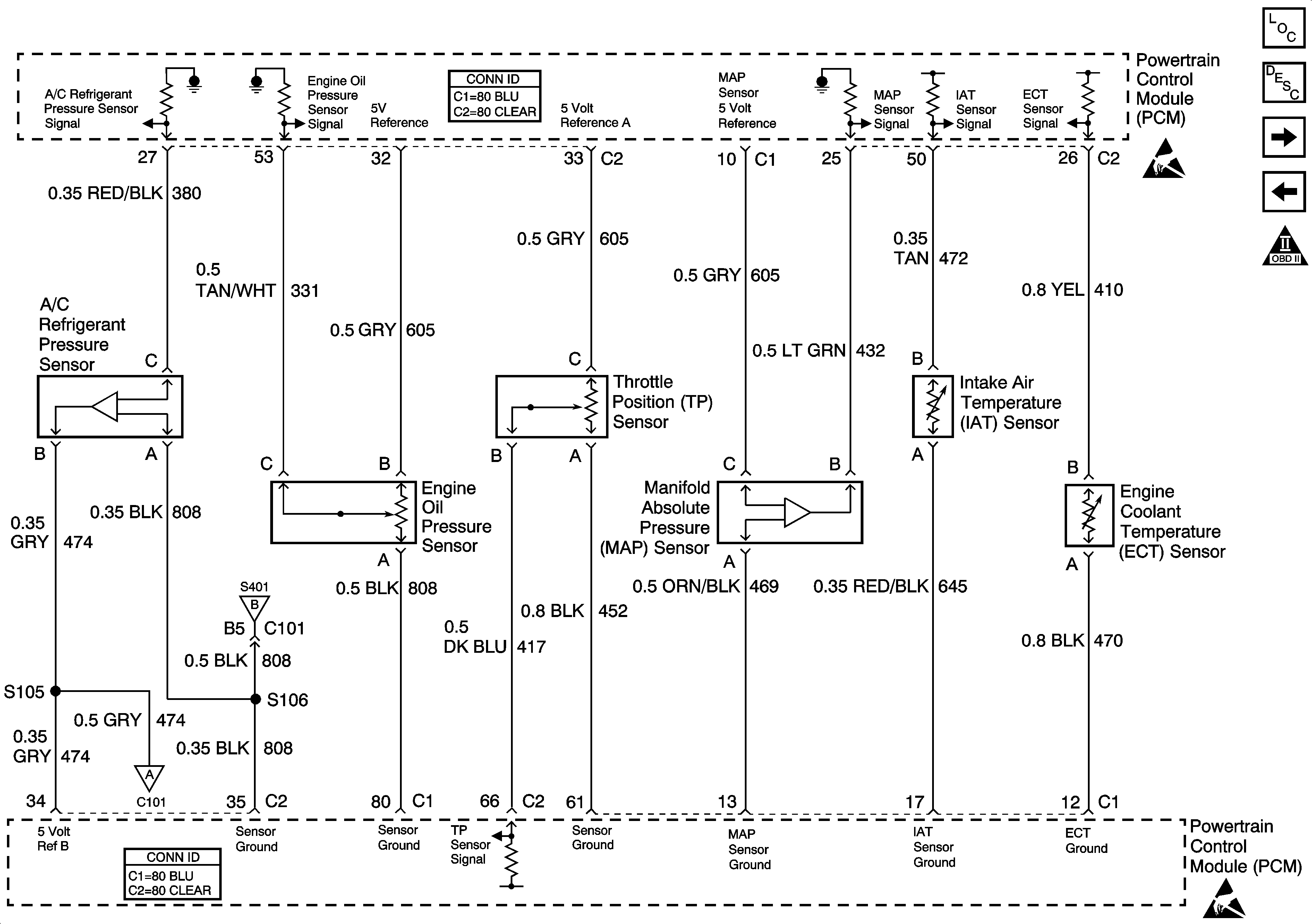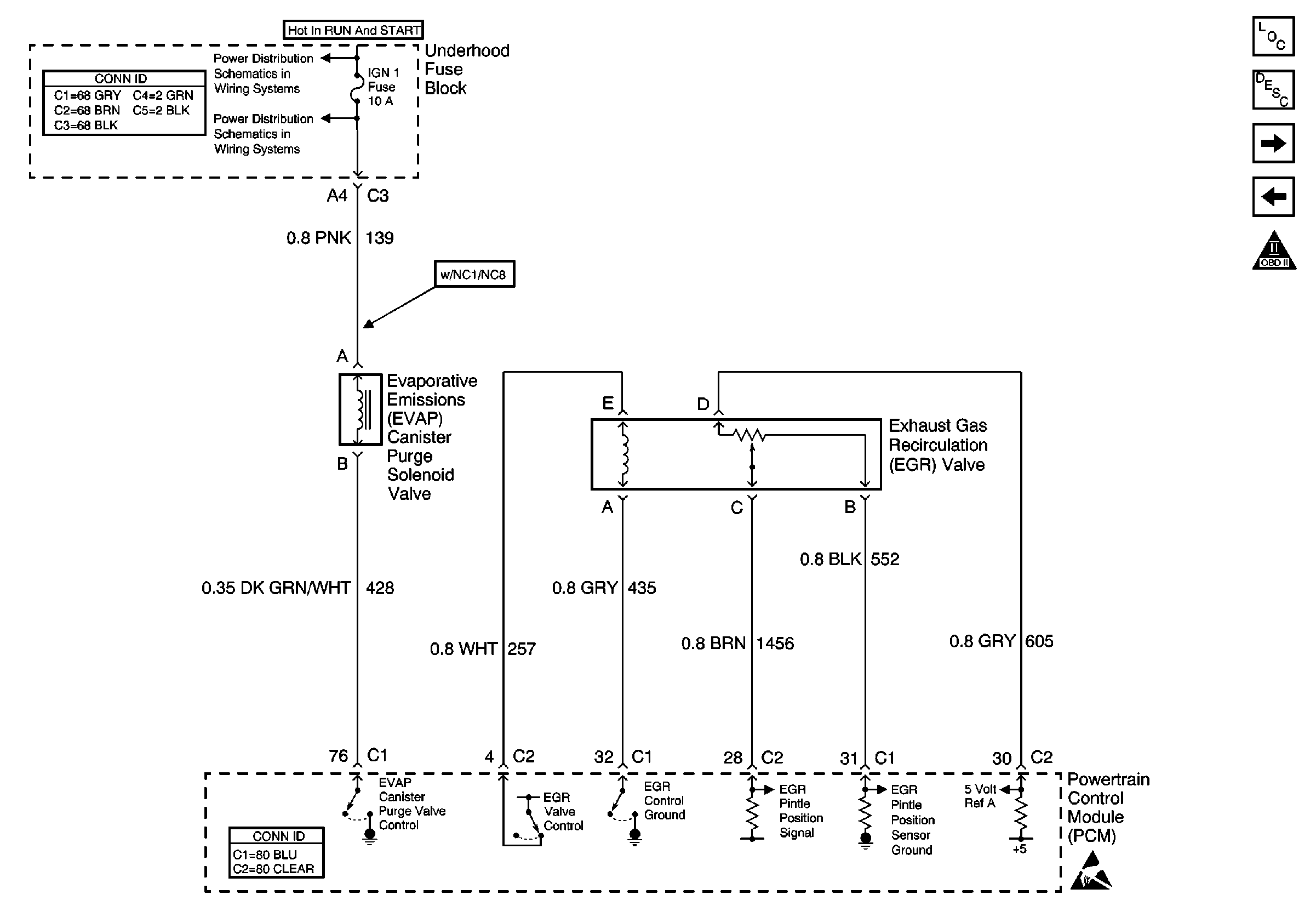Refer to
Sensors

and
Secondary Air Bypass Valve, EGR Valve

for wiring diagrams.
Circuit Description
The PCM uses the 5 volt reference A circuit as a sensor feed to the following sensors:
| • | The fuel tank pressure sensor |
| • | The TP sensor |
| • | The MAP sensor |
| • | The EGR valve pintle position sensor |
| • | The engine oil pressure sensor |
The PCM monitors the voltage on the 5 Volt Reference A circuit. If the voltage is out of tolerance, the PCM will set DTC P1635.
Conditions for Running the DTC
The ignition is on.
Conditions for Setting the DTC
| • | The PCM detects a voltage out of tolerance condition on the 5 volt reference A circuit. |
| • | The above condition is present for longer than 10 seconds. |
Action Taken When the DTC Sets
| • | The PCM will illuminate the MIL during the second consecutive trip in which the diagnostic test has been run and failed. |
| • | The PCM will store conditions which were present when the DTC set as Freeze Frame and Fail Records data. |
Conditions for Clearing the MIL/DTC
| • | The PCM will turn the MIL OFF during the third consecutive trip in which the diagnostic runs and passes. |
| • | The history DTC will clear after 40 consecutive warm-up cycles have occurred without a malfunction. |
| • | The DTC can be cleared by using the scan tool Clear Info function or by disconnecting the PCM battery feed. |
Diagnostic Aids
Important:: Be sure to inspect PCM and engine grounds for being secure and clean.
Check for the following conditions:
| • | A faulty connection at the PCM--Inspect harness connectors for backed out terminals, improper mating, broken locks, improperly formed or damaged terminals, and poor terminal to wire connection. Use a corresponding mating terminal to test for proper terminal tension. |
| • | A damaged harness--Inspect the wiring harness for damage. If the harness appears to be OK, observe the MAP display on the scan tool with the ignition ON, engine not running while moving connectors and wiring harnesses related to the following sensors. A change in the MAP display will indicate the location of the malfunction. |
| - | The fuel tank pressure sensor |
| - | The TP sensor |
| - | The MAP sensor |
| - | The EGR valve |
| - | The engine oil pressure sensor. |
Reviewing the Fail Records vehicle mileage since the diagnostic test last failed may help determine how often the condition that caused the DTC to be set occurs. This may assist in diagnosing the condition.
Test Description
The numbers below refer to the step numbers on the diagnostic table.
Step | Action | Value(s) | Yes | No |
|---|---|---|---|---|
1 | Was the Powertrain On-Board Diagnostic (OBD) System Check performed? | -- | ||
2 |
Was a problem found? | -- | ||
3 |
Is voltage near the specified value indicated? | 5 V | ||
4 | Is voltage near the specified value indicated? | 0 V | ||
5 |
Is the voltage near the specified value indicated? | 5 V | ||
6 |
Was a component replaced? | -- | ||
7 |
Was a problem found? | -- | ||
8 |
Was a problem found? | -- | ||
9 | Replace the EGR valve. Refer to Exhaust Gas Recirculation Valve Replacement . Is the action complete? | -- | -- | |
|
Important:: The replacement PCM must be programmed. Replace PCM. Refer to Powertrain Control Module Replacement/Programming . Is the action complete? | -- | -- | ||
11 |
Does the scan tool indicate DTC P1635 failed this ignition? | -- | System OK |
